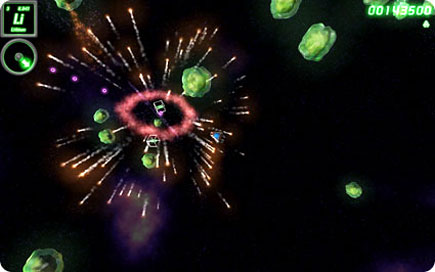- Site: Pangea Arcade
- Publisher: Pangea Software
- Developer: Pangea Software
- Genre: Action
Game Media
By Brad Cook
A spaceship zips through the lonely cosmos, blasting all manner of space debris in its path. Rocket launchers defend power stations against attack by incoming warheads. A ship destroys worms that wiggle through a field of obstacles.

That may sound like another day at the arcade, circa 1982, but it’s really a few minutes taking a break on your Mac, where the thrills of yesteryear have been updated with spectacular effects and sound. Nucleus, Warheads, and Firefall emulate some well-known arcade classics as they take action-packed, white-knuckle gameplay to a new level.
Take a Trip Through the Periodic Table With Nucleus
Rather than simply destroy asteroids and UFOs, Nucleus tasks you with gathering the electrons sometimes left behind by the asteroids, crystals, blobs, and other objects floating through space. Take the electrons to the nucleus and form an atom, which collapses into a black hole that pulls in everything near it, including you.
Get out of the way and start gathering electrons for the next nucleus. Collect power-ups by destroying debris or by firing on power-up pods that unload a pile of them. They offer a variety of boosts, from score bonuses to better weapons to temporary shields to a free life.
A Missile Defense Shield That Actually Works
Warheads places you on another planet, where you must defend the power stations in four sectors from enemy attack. Each sector features three rocket launchers that you use to destroy incoming missiles. Don’t fire indiscriminately, however, because each launcher has a limited number of rockets.
Occasionally, power-ups float from the sky on parachutes. Shoot them down to get better rockets, stock up on ammo, or earn extra points. Don’t let the power-ups reach the ground, though, because they’ll turn into bombs that could take out a power station or a rocket launcher.
Zap the Bugs
In Firefall, you move around the bottom portion of the screen, destroying the ever-faster worms that wiggle through a field full of barriers. You can destroy the barriers, but it takes several shots to knock out each one. Some of them are reinforced and thus impossible to destroy — more of that type enter the field continuously during each level, but you can shoot them while they’re moving.
Other enemies also appear at random times: Streamers, which drop from the top of the field and leave barriers in their wake; Screws, which enter from the sides of the field; and Buzz Saws, which chase you around the screen. Luckily, a wide array of power-ups fall randomly from destroyed barriers, giving you better weapons, invincibility, shields, and other bonuses for short periods of time.
Game Hardware
Check out our systems for your best gaming experience.

Nucleus. A power-up pod unloads its goodies.

Warheads. A power station explodes, but there are five left.

Firefall. A Streamer drops from the top while a reinforced barrier moves in from the side. Good luck.
If you liked this game, check out:
System Requirements:
- Mac OS X version 10.3.9
- 1GHz PowerPC G4 or Intel processor
- 512MB of RAM
- 64MB video RAM
Classic Inspiration
Pangea Software founder Brian Greenstone found the inspiration for Nucleus, Firefall, and Warheads in the classic arcade games Asteroids, Centipede, and Missile Command, respectively. All three were developed and released by Atari, and each one occupies a unique place in videogame history.
Asteroids

Released in 1979, Asteroids was developed by Ed Logg and Lyle Rains. Rains came up with the idea and Logg provided the programming, deciding to go with high-resolution vector graphics rather than then-standard raster graphics, which wouldn’t have offered clean images.
“If you tried to put a little ship like the ship in Asteroids up on standard resolution,” he explains in the book “The Ultimate History of Video Games,” “it would look like garbage. You couldn’t tell what it was … At the time, [vector’s] high resolution was 1024 x 768, and at that resolution, the game would look nice.”
Asteroids proved to be so popular that Lunar Lander, another vector graphics game Atari introduced the same year, was converted to Asteroids on the assembly line. The game’s cabinet even required a larger coin box, to keep it from overflowing before the owner could empty it.
Eventually, players figured out that leaving a couple small asteroids on the screen allowed them to lurk and shoot the UFOs that came through occasionally, racking up enormous scores in the process. One teenager even set a world record, playing for over 36 hours and accumulating more than 41 million points as part of a charity event.
Atari addressed the lurking strategy in Asteroids Deluxe, programming the UFOs to also shoot at the asteroids and end the level, but it was never as popular as its predecessor. Asteroids appeared on many home videogame consoles, including the popular Atari 2600, and you can even play it on your Mac via a downloadable Widget.
Centipede

Logg followed up Asteroids with this one, which he developed with Dona Bailey, who was the only female programmer in Atari’s arcade game division at the time. Centipede was one of the few early arcade games that also appealed to many women, a fact that some attribute to Bailey’s decision to use pastel colors, rather than the bright primary colors typically employed by other designers.
The game, which came out in 1982, was also notable for the variety of techniques players could use, given the assortment of bugs that crawled across the screen. Twin Galaxies, which tracks videogame records, has even divided Centipede achievements into two categories: one where players simply fired at enemies the entire time, and one in which they took advantage of various tricks.
Centipede found its way onto a variety of home videogame consoles and personal computers. It was even turned into a board game in 1983. MacSoft’s Atari Arcade Classics collection includes a 3D version of it, alongside updated editions of Breakout and Pong.
Missile Command

This Dave Theurer-developed game was released in 1980, as the Cold War was entering the Reagan years. “I just had this feeling that this was going to be fun and it was going to be hot,” Theurer recalls in “The Ultimate History of Video Games.” “It was so relevant.”
He also reveals in the book that the final product was a simplified version of a design that originally included a radar screen, trains delivering missiles between the cities, and even submarines. All of it went by the wayside in an attempt to streamline the gameplay.
Later, that simplicity allowed two MIT students to create a modified version of the game called Super Missile Attack. They then used that experience to make modifications to Pac-Man, eventually ending up with Ms. Pac-Man.
Like its Atari contemporaries, Missile Command appeared in cartridge form on the company’s home computers and videogame consoles. It was so popular worldwide that it continued to make money through the mid-1990s, by which time Atari’s arcade games business was owned by competitor Midway Games.
